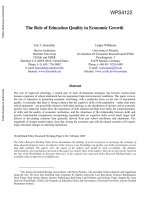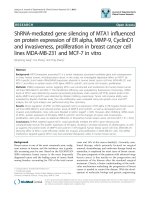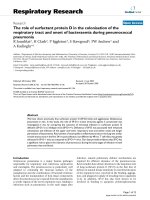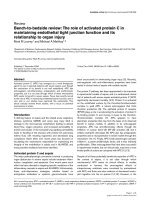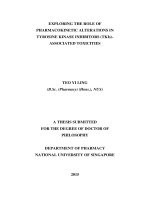The role of prion protein in breast cancer cell metabolism
Bạn đang xem bản rút gọn của tài liệu. Xem và tải ngay bản đầy đủ của tài liệu tại đây (1.16 MB, 112 trang )
THE ROLE OF PRION PROTEIN IN BREAST
CANCER CELL METABOLISM
WONG HUIMIN IRA
BMedSc (Hons) Flinders University
A THESIS SUBMITTED
FOR THE DEGREE OF MASTER OF SCIENCE
DEPARTMENT OF PHYSIOLOGY
NATIONAL UNIVERSITY OF SINGAPORE
2012
I
DECLARATION
I hereby declare that the thesis is my original work and it has been written by
me in its entirety. I have duly acknowledged all sources of information which
have been used in the thesis.
This thesis has also not been submitted for any degree in any university
previously.
____________________________________
Wong Huimin Ira
Feb 2013
II
A. Acknowledgements
I would like to thank my supervisor, Dr Wong Boon Seng, for his support and
advice.
Next, I would like to thank the (past and present) members of the lab including
Lim Mei Li, Dr. Chua Li Min, Yong Shan May, Ong Qi Rui, Dr. Goh Hong
Heng, H’ng Shiau Chen, and Elizabeth Chan. I would like to acknowledge
advice, support, and friendship from Dr. Alvin Loo and Dr. Irwin Cheah.
Lastly, I would like to thank those who are not named in this thesis who have
contributed and supported me.
III
Table of Contents
Declaration ..........................................................................................................I
A. Acknowledgements .................................................................................. III
B. Summary .................................................................................................. VI
C. List of Tables ......................................................................................... VII
D. List of Figures ....................................................................................... VIII
E. Abbreviations ............................................................................................ II
1. Introduction ................................................................................................ 1
1.1. A review of the role of prion protein................................................... 1
1.1.1. Functional characteristics of PrP ................................................. 2
1.1.2. Structural aspects of PrP .............................................................. 3
1.1. Physiological function of PrP .............................................................. 5
1.2. Overview of cancer biology ................................................................ 7
1.2.1. Hallmarks of cancer ..................................................................... 8
1.2.2. The Warburg effect and its effect on cancer cell proliferation .. 11
1.2.3. PI3K/AKT signalling pathway and altered metabolism in cancer
cells ............................................................................................ 15
1.2.4. p53 and its role in altered cancer cell metabolism ..................... 18
1.3. The Role of PrP in cancer biology .................................................... 21
1.3.1. PrP and apoptosis ....................................................................... 21
1.3.2. PrP and cancer biology .............................................................. 24
1.3.3. PrP and breast cancer biology .................................................... 26
1.4. Aims and hypothesis ......................................................................... 27
2. Materials and Methods ............................................................................. 30
2.1. Materials ............................................................................................ 30
2.2. Cell culture/cell lines ......................................................................... 32
2.2.1. MCF10A (CRL-10317TM) ......................................................... 32
2.2.2. MCF7 (HTB-22) ........................................................................ 33
2.2.3. SK-BR-3 (HTB-30) ................................................................... 33
2.2.4. MDA-MB-231 (HTB-26) .......................................................... 33
2.3. Quantitative real-time PCR analysis ................................................. 33
2.3.1. Isolation of total RNA ................................................................ 33
2.3.2. Reverse transcription of RNA .................................................... 34
2.3.3. Quantitative real-time PCR ........................................................ 34
2.3.4. TaqMan® probes ....................................................................... 35
2.4. Western blotting ................................................................................ 36
2.4.1. Cell lysis..................................................................................... 36
2.4.2. Tissue lysis ................................................................................. 36
2.4.3. SDS PAGE and western blotting ............................................... 37
2.5. Molecular cloning ............................................................................. 40
2.5.1. Gateway cloning ........................................................................ 40
2.5.2. LR cloning ................................................................................. 41
2.6. Cell transfection ................................................................................ 42
2.6.1. Dose response curve of MCF7 cells .......................................... 42
2.6.2. Stable transfection of cell lines using nucleofection.................. 43
2.6.3. Selection of transfected cell clones ............................................ 44
2.7. BrdU assay ........................................................................................ 44
2.8. Lactate assay ..................................................................................... 45
2.9. Pyruvate assay ................................................................................... 46
2.10.
Lactate dehydrogenase activity assay ............................................ 47
IV
2.11.
Statistical analysis.......................................................................... 47
3. Results ...................................................................................................... 48
3.1. Breast cancer tissues.......................................................................... 48
3.1.1. Low PrP protein expression in breast cancer tissues ................ 48
3.1.2. p53 protein expression remains unchanged in breast cancer
tissues ......................................................................................... 49
3.1.3. Breast cancer tissue have increased total Akt protein expression
but not phosphorylated Akt ........................................................ 50
3.2. Breast cancer cell lines ...................................................................... 53
3.2.1. PrP expression is higher in normal breast cell line than breast
cancer cell lines .......................................................................... 53
3.2.2. Low PrP expression correlates with high proliferation rate in
breast cancer cell lines. .............................................................. 55
3.2.3. p53 expression is markedly up-regulated in breast cancer cell
lines SK-BR-3 and MDA-MB-231 ............................................ 57
3.2.4. Low PrP expressing breast cancer cell lines is associated with
high Akt and induce Akt phosphorylation ................................. 58
3.2.5. Low PrP expression is correlated with increased glycolytic flux
metabolites ................................................................................. 61
3.3. Transfected cell lines ......................................................................... 64
3.3.1. Over-expressing PrP in MCF7 cell line ..................................... 64
3.3.2. PrP reduces cell proliferation rate .............................................. 66
3.3.3. PrP reduces lactate production in HuPrP/MCF7 cells .............. 67
3.3.4. Overexpression of PrP reduced phospho-Akt (ser473) but has no
effect on total Akt and phospho-Akt (thr307)............................ 68
3.3.5. PrP does not modulate p53 expression ...................................... 71
3.3.6. Over-expressed PrP reduced GLUT4 but not GLUT1 expression
in MCF7 cells. ............................................................................ 72
4. Discussion ................................................................................................ 74
4.1. Concluding remarks and future directions ........................................ 87
5. References ................................................................................................ 90
V
B. Summary
Breast cancer is the major cause of cancer death in women in Singapore. The
incidence of breast cancer will continue to escalate, owing to multiple factors.
These include increased life expectancy and earlier detection, which ironically,
arise from better nutrition, improved medical and healthcare, and national
screening programs. The current paucity of early diagnostic markers, calls for
a need to further understand the aetiology of breast cancer to provide better
treatment and prevention. Breast cancer cells have been shown to exhibit the
Warburg effect characterised by increased levels of glycolytic enzymes,
glucose consumption and lactate production. Prion protein (PrP), a highly
conserved cell surface glycoprotein known to cause neurodegenerative prion
disease in human has also been implicated in cancer progression.
In this project, we assessed the effect of PrP in breast cancer cells using two
PrP over-expressing cell lines, namely human PrP MCF7 clone A
(HuPrP/MCF7 clone A) and HuPrP/MCF7 clone B, in order to ratify our
hypothesis. We found that increased PrP expression was associated with
reduced proliferation rate both in a variety of breast cancer cell lines and in
PrP over-expressing MCF7 cells. Our results, while preliminary, showed that
PrP is associated with phosphorylated Akt at serine 473 reducing glucose
transporter 4 (GLUT4) expression, resulting in increased lactate production.
We speculate that PrP modulates breast cancer metabolism and is likely to be
linked to the Warburg effect.
VI
C. List of Tables
List of Tables
Table 1
Table 2
Table 3
Table 4
Table 5
Title
Biochemical and biophysical properties of PrPC
and PrPSC
Role of p53 in metabolism
PCR reaction mix
Antibodies for Western blotting analysis
Cycling conditions for PCR
VII
Page
3
19
35
39
40
D. List of Figures
List of Figures
Figure 1
Figure 2
Figure 3
Figure 4
Figure 5
Figure 6
Figure 7
Figure 8
Figure 9
Figure 10
Figure 11
Figure 12
Figure 13
Figure 14
Figure 15
Figure 16
Figure 17
Figure 18
Figure 19
Figure 20
Figure 21
Title
Picture showing primary structure of PrP
Picture showing the difference between oxidative
phosphorylation, anaerobic glycolysis, and aerobic
glycolysis (Warburg effect)
Picture showing the downstream substrates of Akt
and its respective function
Schematic overview of PI3K/Akt signaling
pathway
A representative standard curve with six points for
protein quantification by BCA protein assay
A representation of the lactate standard curve
PrP expression is reduced in breast ancer tissue
p53 expression remains unchanged in breast cancer
tissue
Breast cancer tissue is associated with increased
total Akt but not phosphorylated Akt expression
PrP expression is higher in normal breast cell line
(MCF10A) than breast cancer cell lines (MCF7,
SK-BR-3, and MDA-MB-231)
Proliferation rate in breast cancer cell lines
Up-regulation of p53 in breast cancer cell lines but
not MCF7
Low PrP expression in breast cancer cell lines is
associated with high Akt expression and induced
Akt phosphorylation
Correlation between LDH-A activity, intracellular
levels of pyruvate and lactate production in breast
cancer cell lines
Over-expressing PrP in MCF7 breast cell line
Over-expressing PrP in transfected MCF7 cells
reduces cell proliferation rate
Over-expressing PrP in transfected MCF7 cells
reduces lactate production
Over-expressing PrP in transfected MCF7 cells
reduces p-Akt (ser473) but has no effect on total
Akt and p-Akt (thr308)
Over-expressed PrP in MCF7 cells does not affect
p53 expression
Over-expressing PrP in transfected MCF7 cells
reduces GLUT4 expression but not GLUT1
PrP expression correlates with
invasiveness/malignancy of the breast cancer cell
lines
VIII
Page
4
14
15
16
38
46
48
49
51-52
54
56
57
59-60
62-63
65
66
67
69-70
71
72-73
78
Figure 22
Figure 23
Figure 24
Schematic overview of the role of PrP in breast
cancer metabolism in the study model
Picture showing different lactate production in
normal and cancer situation
Schematic overview of the role of PrP in cancer
metabolism in breast cancer cells
I
80
82
83
E. Abbreviations
AMV RT
Avian myeloblastosis virus reverse transcriptase
ANOVA
Analysis of Variance
ATP
Adenosine triphosphate
BCA
Bicinchoninic acid
BLAST
Basic local alignment search tool
BrdU
Bromodeoxyuridine
BSA
Bovine serum albumin
cDNA
Complementary deoxyribonucleic acid
CJD
Creutzfeldt-Jakob disease
CNS
Central nervous system
DMEM
Dulbecco’s Modified Eagle’s Medium
dNTP
Deoxynucleotide triphosphate
ER
Estrogen receptor
FBS
Fetal bovine serum
GLUT1
Glucose transporter 1
GLUT4
Glucose transporter 4
hEGF
Human epidermal growth factor
HRP
Horseradish peroxidase
HEK293
Human embryonic kidney 293
LB
Luria-Betani
LDH
Lactate dehydrogenase
mTORC2
Mammalian target of rapamycin complex 2
NAD+
Nicotinamide adenine dinucleotide
II
NADH
Nicotinamide adenine dinucleotide (reduced)
NADPH
Nicotinamide adenine dinucleotide phosphate
NCBI
National Centre for Biotechnology Information
NUS
National University of Singapore
PBS
Phosphate buffered saline
PBST
Phosphate buffered saline tween-20
PCR
Polymerase chain reaction
PDK1
3-phosphoinositide-dependent protein kinase-1
PI3K
Phosphoinositide 3-kinase
PIP2
Phosphatidylinositol (3,4,5)-triphosphate
PIP3
Phosphatidylinositol (3,4,5)-triphosphate
PrP
Prion protein
PrPC
Cellular prion protein
PrPSc
Scrapie form of prion protein
PTEN
Phosphatase and tensin homolog
RIPA
Radioimmunoprecipitation assay
ROS
Reactive oxygen species
RT
Room temperature
SCO2
Synthesis of cytochrome c oxidase 2
S.D.
Standard deviation
Ser473
Serine 473
S.E.M.
Standard error of the mean
TCA
Tricarboxylic acid
TEMED
N,N,N',N'-tetramethylethylenediamine
Thr308
Threonine 308
III
TIGAR
TP53-induced glycolysis and apoptosis regulator
TNF-α
Tumor necrosis factor-α
TSE
Transmissible spongiform encephalopathy
IV
1. INTRODUCTION
1.1.
A review of the role of prion protein
Prion is an acronym for proteinaceous infectious particle (Prusiner, 1982).
Prion diseases, also known as transmissible spongiform encephalopathies
(TSEs) (Sy et al., 2002), are a group of animal and human neurodegenerative
disorders that are invariably fatal. They are often characterized by a long
incubation period resulting in neuronal loss, spongiform changes and
astrogliosis (Belay, 1999). Some examples of TSEs include CJD, GerstmannStraussler-Scheinker syndrome, fatal familial insomnia, kuru and many more
(McNally et al., 2009). Prion diseases are infectious from exogenous sources,
sporadic and/or genetic where the gene encoding the PrP is mutated (Prusiner,
1998). The mechanism of how prion causes brain damage is poorly understood.
It was hypothesized that the key event underlying the development of prion
disease is the post-translational conversion of normal cellular PrP (PrPC), a
cell surface glycoprotein, into its pathogenic isoform, the scrapie prion (PrPSc)
(Prusiner et al., 1998, Tuite and Serio, 2010) leading to progressive neuronal
accumulation of the latter. This in turn causes irreversible damage to the
neurons and reduces the availability of PrPC which may interfere with the
presumed neuroprotective role of the protein, thus resulting in the underlying
neurodegenerative process (Belay et al., 2005).
1
Prion diseases have received the limelight following an outbreak of bovine
spongiform encephalopathy (BSE) infecting several cattle in Europe and
scientific evidence implicating foodborne transmission of BSE to humans
resulting in a lethal disease called variant CJD (Will et al., 1996). Although
much is known of the role of PrP in disease processes, the normal function of
PrP remains unclear.
Our research laboratory has extensive experience working on prion diseases
(Wong et al., 2001a, Wong et al., 2001b, Wong et al., 2001c). With the recent
research emphasis on PrP and its role in cancer, we decided to divest our
efforts into this area as well. Before we proceed further, it is perhaps pertinent
that we first look at the normal functions and current understanding of PrP in
both normal, as well as in cancer development. Unless otherwise stated, the
term ‘PrP’ as used in this thesis denotes the normal cellular form PrPC.
1.1.1.
Functional characteristics of PrP
PrP is encoded by the highly conserved PRNP gene, consisting of two or three
exons depending on the species. In humans, the PRNP gene has two exons
with the entire open reading frame located in a single exon, localized in
p12/p13 region of chromosome 20 (Basler et al., 1986). PrP is expressed in
many organs such as the lung, heart, kidneys, gastrointestinal tract, muscle,
and mammary glands, with the highest expression found in the central nervous
system (Stahl et al., 1987, Brown et al., 1990, Bendheim et al., 1992).
Although both the PrPc and PrPsc share the same primary structures, the
2
former is rich in α-helical secondary structures (Riek et al., 1997, Knaus et al.,
2001), soluble in mild detergents (Meyer et al., 1986), exists in a stable
monomeric state, and is sensitive to proteinase-K degradation (Stohr et al.,
2008, Prusiner et al., 1983). Table 1 shows the comparison between the
biochemical and biophysical characteristics of PrPc and PrPsc.
Table 1: Biochemical and biophysical properties of PrPc and PrPsc. (Table
modified from (Govaerts et al., 2004).
PrPC
PrPSc
Non infectious
Infectious
Mainly α-helices
Mainly β-sheets
Protease K sensitive
Protease K insensitive
Does not aggregate
Aggregate
1.1.2.
Structural aspects of PrP
In humans, PrP is initially synthesized as a pre-pro-PrP of 253 amino acids in
the cytosol. PrP contains a hydrophobic N-terminal signal peptide of 22 amino
acids while the last 22 amino acids at the C-terminus encompass the GPI
anchor peptide signal sequence. Cleavage of both of these sequences results in
the mature 209 amino acid residue PrP being exported to the cell surface as an
N-glycosylated,
glycosylphosphatidylinositol-anchored
protein.
Nuclear
magnetic resonance at acidic pH reveals that PrP consists of a highlyconserved hydrophobic region (residues 106-126), a NH2-terminal flexible tail
(residues 23-124), and a COOH-terminal globular domain (residues 125-228),
3
arranged in three monomeric α-helices, and two short β -strands flanking the
first α -helix (Zahn et al., 2000). A single disulfide bond is found between
cysteine residues 179 and 214. There are three sites responsible for copper
binding which are found in the octarepeat region (residues 51-91) (AronoffSpencer et al., 2000). Figure 1 shows the primary structure of PrP.
Full-length human PrP consists of two N-glycosylation sites at asparagine 181
and 197 (Haraguchi et al., 1989, Stahl et al., 1987) and can exist in three forms
as the di-, mono-, or unglycosylated isoforms (Harris, 1999, Lehmann et al.,
1999). The functions of N-linked glycans include glycoprotein trafficking,
structure maintenance, and may contribute to the functional properties of
membrane-associated PrP (Fiedler and Simons, 1995, Varki, 1993).
Figure 1: Picture showing primary structure of PrP. (Figure taken from
(Ermonval et al., 2003). PrP consists of a highly-conserved hydrophobic
region, a N-terminal region, and a C-terminal region. The latter composed of
three monomeric α-helices, and two short β-strands flanking the first α-helix.
A single unique disulphide bridge between the two cysteines is also found in
the C-terminus domain. An octarepeat region encompassing the codon 51
through 91 of the N-terminus is responsible for copper binding.
4
1.1.
Physiological function of PrP
While most studies are focused on the role of PrP in neurodegenerative
diseases, its function outside the nervous system remains unclear. Some of the
hypothesized functions of PrP include protection against apoptosis and
oxidative stress, cellular survival, proliferation, differentiation, cellular uptake
or binding of copper ions, transmembrane signalling, formation and
maintenance of synapses and adhesion to the extracellular matrix (Nicolas et
al., 2009, Westergard et al., 2007).
The role of PrP in cell signalling pathways has been shown in a study where
PrP was found to be localized in the lipid raft domains on the plasma
membrane enriched in sphingolipids and cholesterol (Petrakis and Sklaviadis,
2006). Further research into the signal transduction patterns suggests that PrP
might have a role in activating various transmembrane signalling pathways
responsible for neurite outgrowth, neuronal survival or differentiation and
neurotoxicity (Westergard et al., 2007). Using Prnp0/0 mice, where PrP had
been deleted, impairment of the PI3K/Akt signalling pathway upon downregulation of post-ischaemic phospho-Akt expression, following postischaemic Caspase-3 activation, and neuronal injury aggravation after focal
cerebral ischaemia was shown. This thus suggested a neuroprotective role of
PrP through regulation of the PI3K/Akt pathway (Weise et al., 2006).
Contrariwise, the neurotoxic effect of PrP was demonstrated to be induced via
specific signalling cascade. Synthetic peptide PrP 106-126 which displays
similar biochemical properties with PrPSC triggers PrPC signalling pathways
5
possibly through the JNK/c-Jun pathway where its activation is responsible for
the PrPC mediated neurotoxicity(Carimalo et al., 2005, Pietri et al., 2006).
The role of PrP in synapses was predicated upon PrP expression being upregulated at synapses, suggesting that it might play an important role in
synaptic structure, function and maintenance. Kanaani et al. showed that
exposure of cultured rat fetal hippocampal neurons to purified recombinant
PrP resulted in rapid elaboration of axons and dendrites, and increase in
synaptic contacts (Kanaani et al., 2005). Similarly, in another study, PrP
facilitated synaptic transmission by inducing acetylcholine release potentiation
at the neuromuscular junction (Re et al., 2006). Others have also shown PrP
involvement in synapse formation and function which include reorganization
of mossy fibre, circadian activity alterations, and cognition deficits in mice
devoid of PrP (Colling et al., 1997, Criado et al., 2005, Tobler et al., 1996).
The role of PrP in cell adhesion regulation was demonstrated in a study where
PrP interacts with cell adhesion molecules such as neural cell-adhesion
molecule (N-CAM). This led to the redistribution of N-CAM to lipid rafts and
the activation of fyn kinase, an enzyme involved in N-CAM-mediated
signalling. This process subsequently further enhanced neurite outgrowth in
cultured hippocampal neurons (Santuccione et al., 2005). Graner et al.
demonstrated using PC12 cells and hippocampal neurons that PrP was
saturable, having specific and high-affinity receptors to laminin, which are
responsible for cell proliferation, neurite outgrowth, and cellular migration
(Graner et al., 2000).
6
1.2.
Overview of cancer biology
Cancer, also known as malignant neoplasm, is a type of genetic disease where
a group of cells display uncontrolled growth (cell division beyond normal
limits), invasion (invade and disrupt adjacent tissues), and oftentimes
metastasis (spread to other parts of the body via the blood or lymph) (Alteri,
2011).
Cancer is the leading cause of death worldwide accounting for 7.6 million
deaths, approximately 13% of all deaths in 2008. The top cancer deaths
include lung, stomach, liver, colon, and breast cancer. Deaths from cancer
worldwide are expected to continue increasing, with an estimated 13 million
deaths in 2030 (WHO, 2012). In Singapore alone, cancer is the major cause of
death (Singstat, 2011). As such no effort has been spared in the search for
curative, as well as palliative treatments over the past several decades. Success
has been limited and the field remains a vibrant and actively researched area.
Several hallmarks of cancer contribute to these challenges encountered in
research and are detailed in the following sections.
As an example, breast cancer is a malignancy that affects breast tissue, in
particular, the inner lining of milk ducts or the lobules that supply the duct
with milk (Sariego, 2010). These are termed ductal and lobular respectively.
Breast cancer is the leading cause of cancer mortality in Singaporean females
(MOH, 2012). Amongst all the different kinds of cancer, breast cancer is
ranked fifth highest in terms of mortality rate (WHO, 2008), while according
7
to the Singapore Cancer Registry, 1 in 17 women will develop breast cancer in
her lifetime in Singapore. The risk of getting breast cancer increases with age,
with the most prevalent age between 50 to 59 years in Singapore women (HPB,
2009).
1.2.1.
Hallmarks of cancer
How then is a cancer cell different from a normal cell? Many researchers over
the past decades have been studying this question. They found that most, if not
all cancers have acquired the same set of features during their development as
they become cancerous. These hallmarks include the ability to generate selfsustaining growth signals, insensitivity to growth-suppressor signals,
resistance to programmed cell death (apoptosis), unlimited replication
potential, sustained angiogenesis, tissue invasion and metastasis (Hanahan and
Weinberg, 2000) and altered metabolism (DeBerardinis et al., 2008, Warburg,
1956).
As the cells progress to the cancerous stage, the reliance on exogenous growth
stimulation decreases and are replaced by their own signalling which involves
alteration of extracellular growth signals, transcellular transducers of those
signals, or intracellular circuits that translate those signals into action
(Hanahan and Weinberg, 2000). Platelet-derived growth factor and tumour
growth factor alpha (TNFα) are examples of cancer cell’s growth signals in
glioblastomas and sarcomas respectively. Cancer cells have the ability to act
as though growth hormones are present (despite an actual absence of it), thus
8
creating a positive feedback loop known as autocrine stimulation (Heasley,
2001). Nonetheless, cancer cells are capable of evading antigrowth signals
possibly via modifying the components governing the transit of cells through
the G1-phase of its proliferative cycle. This in turn allows the cancer cell to
maintain their replicative capacities and fuel their uncontrolled growth and
division (Hanahan and Weinberg, 2000).
Apoptosis is an important process for normal development and it is a way to
remove cells with DNA damage. Unlike normal cells, cancer cells are able to
evade apoptosis, which result in infinite growth and division (Hanahan and
Weinberg, 2000). p53, the tumour suppressor gene, is an important target of
cancer. Approximately 50% of all human cancers show defects involving p53,
resulting in functional inactivation of its product and subsequent removal of a
key component of the DNA damage sensor that can induce the apoptotic
effector cascade (Harris, 1996).
Also, under normal circumstances, with each successive cell division,
telomeres progressively shorten by about 50-100 bp. This eventually halts cell
division as the telomeres become too short, hence resulting in replicative cell
senescence (Counter et al., 1992).
Cancer cells however achieve
immortalization and infinite replicative potential through lengthening their
telomeres via the addition of hexanucleotide repeats by the action of
telomerase enzyme on the ends of telomeric DNA (Bryan and Cech, 1999).
9
In order for cancer cells to sustain growth, cellular function and survival, it is
essential for cancer cells to induce angiogenesis (formation of new blood
vessels and sustained blood vessel growth) for oxygen and nutrient supply
(Hanahan and Weinberg, 2000). This switch is induced by modulating the
balance of angiogenesis inducers and countervailing inhibitors, probably
involving gene transcription (Hanahan and Folkman, 1996).
As cancer cells acquire genetic alterations making them autonomous, it gives
them the ability to separate from the primary tumour, spreading via the
lymphatics and blood vessels, and invading into other parts of the body to
form secondary lesions. This ability to spread and ‘reside’ in other parts of the
body is known as metastasis — the final stage of cancer development that
causes 90% of human cancer deaths (Sporn, 1996).
Altered metabolism is a hallmark initially described nearly a century ago,
showing the differential aspects of cellular metabolism in cancer cells relative
to normal differentiated cells (DeBerardinis et al., 2008, Warburg, 1956). This
hallmark is very important for cancer cells as they need to satisfy the intense
demands for growth and proliferation. Advancements over the past decade
have shown that the aberrant cellular metabolism of cancer is caused by a
combination of genetic lesions and nongenetic factors such as the tumour
microenvironment (Hsu and Sabatini, 2008, Vander Heiden et al., 2009).
However, there remains innumerable gaps in our knowledge of how, what, and
where cancer cells rewire their cellular metabolism, due to the fact that cancer
itself is a disease that is complex and heterogenous in nature. As such, a single
10
model of altered tumour metabolism will not fully encapsulate the sum of
metabolic changes that can support cancer cell growth (Greaves and Maley,
2012). Thus, any investigation into cancer cell metabolism will lend support to
delineating missing pieces of the puzzle, with the grand aim of advancing
knowledge that leads ultimately to discoveries of novel cancer treatment
options.
In the next section, I will discuss in greater depth what the altered metabolism
in cancer cells is, how it differs from normal cells, and why this is so vital to
cancer cell proliferation.
1.2.2.
The Warburg effect and its effect on cancer cell
proliferation
Generally, the cellular processes for cell proliferation and metabolism are
closely knit (Fritz and Fajas, 2010). The metabolic programme of normal
resting cells function to maintain homeostatic processes through adenosine
triphoshate (ATP) production (Vander Heiden et al., 2009). In the presence of
oxygen, most normal resting cells metabolize glucose to pyruvate through
glycolysis, and then completely oxidize a large fraction of the generated
pyruvate to carbon dioxide in the mitochondria through oxidative
phosphorylation. This process yields 36 ATP from one molecule of glucose
(Fig 2). However, in the absence of oxygen, normal cells redirect pyruvate
away from mitochondrial oxidation or tricarboxylic acid (TCA) cycle and
instead largely reduce it to lactate via anaerobic glycolysis (Vander Heiden et
al., 2009).
11
In normal proliferating cells, the metabolic programme must generate enough
energy to support cell replication and also meet the energetic requirements for
anabolic demands from macromolecular biosynthesis and maintenance of
cellular redox homeostasis in response to increased production of toxic
reactive oxygen species (ROS). ROS are produced during stressful situations
in the cell and they are highly reactive radicals capable of causing significant
damage to cell structures. Too much ROS in the cells cause oxidative stress,
resulting in cells arresting in cell-cycle, and after prolonged arrest, death from
apoptosis. This is not favourable to cells which are undergoing proliferation
(Burhans and Heintz, 2009). However, ROS are not always deleterious: they
act as messengers in signalling cascades involved in cell proliferation and
differentiation. For example, ROS are produced at low concentrations during
the interaction between growth factors and receptors. This is essential to
activate proliferative signalling for cell division (Chiu and Dawes, 2012). Thus
there is a need for redox homeostasis in the cell. This process is also a
significant requirement for a growing tumour cell (Cantor and Sabatini, 2012).
In contrast to normal cells, rapidly proliferating cells or cancer cells
metabolize glucose to lactate, even in the presence of oxygen, despite the
process being far less efficient in net ATP production per molecule of glucose
(Fig 2) (Vander Heiden et al., 2009). Such a process is called ‘aerobic
glycolysis’ or the Warburg effect. Although aerobic glycolysis has low
efficiency in ATP yield per molecule of glucose, it can generate far more
energy than oxidative phosphorylation by producing ATP at a faster rate
(Pfeiffer et al., 2001). It was hypothesized that aerobic glycolysis or the
12
Warburg effect benefits cancer cells in several ways. Firstly, the glycolysis
process is highly interconnected with several other metabolic pathways —
particularly those associated with de novo synthesis of cellular building blocks
where many glycolytic intermediates serve as substrates. This is important for
fast cell growth as it maintains large pool sizes of glycolytic intermediates
such as nicotinamide adenine dinucleotide phosphate (NADPH), acetyl-coA,
and ATP, which are needed for anabolic reactions (Hume and Weidemann,
1979, Vander Heiden et al., 2009). Next, increased aerobic glycolysis is
postulated to support cancer cell survival, growth and invasion by conditioning
the tumour microenvironment (Koukourakis et al., 2006) through starving
their neighbours. This provides cancer cells more opportunities for invasion
and gaining of space for growth (Gillies and Gatenby, 2007). Thirdly, with
more glycolysis more ROS will be produced to increase cell proliferation and
survival via post-translational modification of kinases and phosphatases
(Giannoni et al., 2005, Lee et al., 2002).
The Warburg effect has been clinically exploited for diagnostic benefit
through the use of Positron Emission Tomography (PET) with the glucose
analogue, 2-deoxy-2-[18F] fluoro-D-glucose (FDG), as a tool for detecting and
staging malignancies (Groves et al., 2007). However, drugs that act by
targeting the metabolic alteration in cancer have yet to be developed —
despite much speculation — and may be a potential therapeutic target for
tumour tissues within cancer patients. However, there are challenges that need
to be resolved when targeting tumour metabolism, given that normal
proliferating cells share similar metabolic needs and adaptations (Wang and
13

